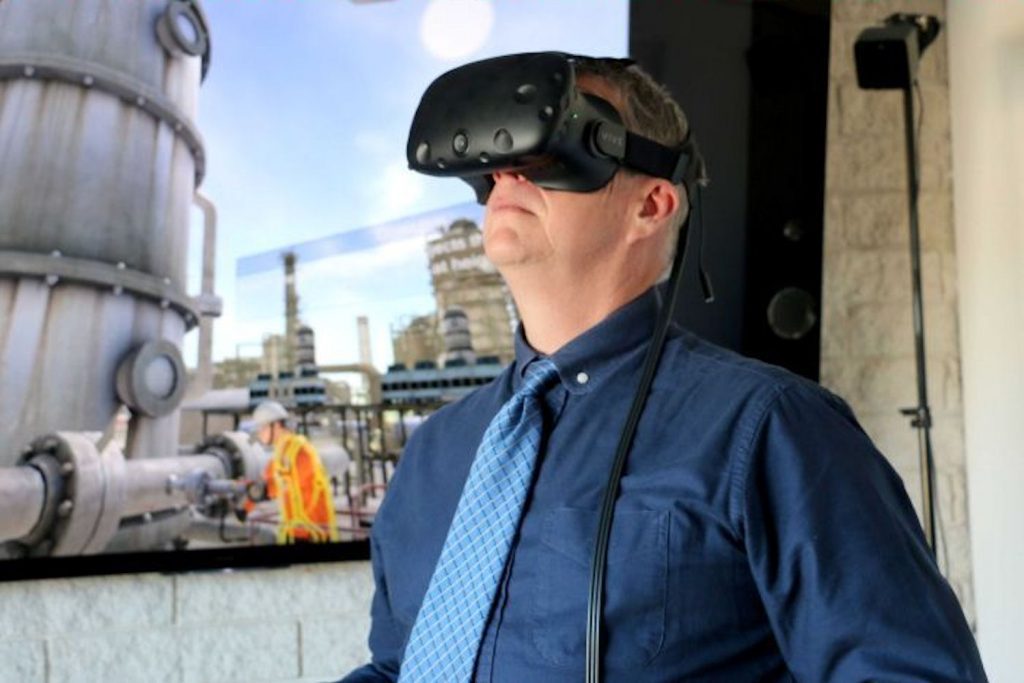 Australian mining companies use technology to save money now that the boom is over [8].
Credit: Australian Broadcasting Corporation/Kathryn Diss.
Australian mining companies use technology to save money now that the boom is over [8].
Credit: Australian Broadcasting Corporation/Kathryn Diss.
Australian Aboriginal Communities, Mining, and Artificial Intelligence
Autonomous vehicles have had a profound impact across the global mining sector, providing efficiency dividends and safety records that were once considered one further failsafe against a downturn of the Australian economy. Fly-in-fly-out (FIFO) workers, however, have already witnessed a shift in their employment status as virtual reality, artificial intelligence, and autonomous vehicles make environment sensing and navigation possible with little or no human input. As radar, lidar, GPS, odometry, and computer vision technologies meld with machinery, a very real threat is now facing Australian Aboriginal communities, that of cyborg CEO consortia from afar operating fleets of autonomous vehicles taking resources off country.
Fluoro Vests & Hard Hats
In 2007 I moved from Sydney to the country town of Orange in New South Wales, Australia. Orange is home to a mixture of agriculture, mining, medical, and manufacturing industries. The retail sector provides a glamorous family-friendly facade to a town that has faced (like many other Australian rural communities) many booms and busts. These cycles are epitomized by the rags to riches stories the mining industry purports to catalyze.
Mining has had an impact on many Aboriginal communities in Australia.
I witnessed first-hand locals welcoming into their township Newcrest Mining [1] employees, wearing high visibility shirts and mud covered boots. Businesses hastily procured, beyond their means, bank loans to outfit their establishments and force-feed the fly-in-fly-out workers fat on paychecks. Rental prices skyrocketed as builders bustled to find enough bricks and mortar to meet demands for new housing.
A few short years later those same retail establishments learned of the threat to their income as the very same FIFO workers began losing shifts, and local businesses lost contracts commensurately. Autonomous systems with names that resemble a science fiction film cast, including Sandvik Automine, Transmin Rocklogic, Controllogix PLC, CitectSCADA, and Yokogawa Centum, all began replacing the FIFO physical labor with omniscient sensor systems.
Fast forward to 2016 and Newcrest announced that 100 workers’ positions could not be maintained, with no mention of the impact of automation or remote control technologies on these job losses [2]: “…The majority of the workforce at Ridgeway will be transferred to Cadia East, but the company said it could not find positions for 100 people. The company said while the figure was lower than first thought, it was a “sobering” time for many of the workers.”
A later report from the local Central Western Daily [3] revised that figure to an estimated 122 workers, and then further to 300 workers by the end of the year, as Cadia East winds up. Again, these statements from Newcrest are made with no mention of the impact of automation technologies on the roles of workers in those locations.
Mining Automation
As we move to a mining sector where dump trucks, underground excavators, loaders, and conveyor systems are transformed into partial or fully autonomous systems, there is little or no human labor required other than to maintain equipment or provide oversight using a range of distant surveillance technologies.
According to International Mining Technology [4], the International Mining Company publication, many mining operators have been removed from the driver’s-seat to the virtual cockpit:
“…AutoMine system is a highly innovative automation system where operators, who would normally drive a single heavy-duty machine underground, can now sit in the comfort and safety of an airconditioned control room on surface, and simultaneously monitor the movements of a fleet of driverless loaders or trucks hundreds of metres below the surface. Sandvik loaders or trucks navigate their way between the load and discharge points under the control of a supervisory system which is managing the traffic and monitoring the machines. AutoMine is equipped with a number of intelligent functions for example, if one of the machines strikes a large rock in the roadway, the system would then place a restriction on the speed in that area to ensure that machines following behind either slow down or stop at the obstacle, thereby reducing potential damage to the equipment.”
According to Australia Mining [5], the mining industry, despite recent advances in automation and the impact that has had on the immediate operator workforce, is in its infancy with automated systems:
“…Currently the industry is in the early days of this evolution, and working through the teething problems typically associated with any new technology. One stand out factor for automation is that it was pegged as being safer than many current techniques, as by removing the man from the operation you remove them from the risk.”
This begs the question that if you remove the human (man or woman) from the operation, then what employment role will that human now fulfill? With only a handful of humans employed to run a fleet of vehicles from afar, is the future of automation in the mining industry another notch in the magic milestone for a dawning Singularity [6]?
Mining Virtualization
In 2012 a Western Australian based company published a press release [7] stating that their virtual meeting software could save valuable human resources, eliminating the need for workers to be on site. Rather they could operate from the comfort of an offsite location (see photo at the beginning of this article).
The same company has recently touted that this virtualization experience, control of equipment, and communication with others is now transformed into real time from anywhere in the world via wearable technologies such as the Oculus Rift [9]:
“…They won’t have to FIFO, they’ll be able to take their work into better places and this is the technology that’s going to be able to enable that,” Mr Bester said” [10].
In the same article, a Perth startup company with its eye on mining technique advancement, Minnovare, is cited as developing a device that helps better target drilling. Romano Sala Tenna from Katana Asset Management states:
“We’re seeing a company list every one to two days with a new technology project, so a resource-based shell that’s given up the ghost on their project and looking at bringing new technology to market. They actually need technology just to survive because the next generation of ore bodies aren’t going to be discovered with traditional technologies.”
Socio-Ethical Impact
Mining has had an impact on many Aboriginal communities in Australia since the first occupation of white settlers arrived, digging like wild rabbits and mad dogs seeking fame and fortune.
Irene Wilson, Committee Office, Department of the Senate, in April 1997 produced a large report titled “Impact of Uranium Mining on Aboriginal Communities in the Northern Territory” [11]. The report outlines social impacts on communities, payment of royalty equivalent monies, and discusses Aboriginal control over, and pressure to consent to, mining; communication, and consultation. The report also addresses development of social impact statements for mining proposals.
A decade later, according to the Centre for Aboriginal Economic Policy Research (CAEPR), in a 2006 report titled “Indigenous People and the Pilbara Mining Boom”:
“…The basic message conveyed is that little has been achieved over the past four decades in terms of enhancing Indigenous socioeconomic status in the Pilbara” [12].
A few years later in the Journal of Energy & Natural Resources Law an article titled “Indigenous Employment in the Australian Mining Industry” states in abstract that:
“…research data from two large mines with substantial Indigenous workforces show that there is potential for positive outcomes to be delivered for Indigenous people who do obtain work in the sector” [13].
Almost 8 years have passed as we examine how one of many communities – who once counted on the backbone of their workforce being locally employed, or on fly-in-fly-out operators spending money in their townships – are coping. It brings into focus the wider impact that this automation will have, beyond the immediate economic or environmental concerns of citizens:
“The Mabo case, the Native Title Act and engagement with the mining industry have changed the assumptions of that (welfare dependent) paradigm and catapulted Aboriginal people engaged in the mining industry into the mainstream economy. I have worked at mine sites and witnessed this extraordinary change … Mining offers many Indigenous populations a significant source of employment and contracting opportunities, as well as an alternative to the welfare transfers upon which many remote and regional Aboriginal communities depend.”
Professor Marcia Langton AM [14]
Contrary to Professor Marcia Langton’s assertion, it is not by choice that Aboriginal communities are dependent on government welfare handouts, nor by choice that they are made dependent on the mining sector (which exploits the very country that Aboriginal communities are custodians of). Rather, we have to question whether Aboriginal communities also have a choice in what automation, artificial intelligence, and faceless international consortia will bring in the near future.
Also, in direct contrast to Professor Marcia Langton’s assertion that mining is a welfare alternative, Ghillar Michael Anderson, leader of the Euahlayi people and ambassador of the Aboriginal Tent Embassy in Canberra, posits that for remote communities the very act of closure:
“…For the Western Australian Government to now dispossess and displace the Peoples of these homelands is designed to facilitate an expeditious expansion of mining interests and other developments” [15].
As mining companies sublease [16] land back to the communities who have lived on that land for 40 000 years, while elsewhere total virtual control of mining operations continues unabated from a capital city 1200 km away [17], the trajectory for dystopic future scenarios are vivid.
Picture for a moment an international consortia-led operation controlling a fleet of tens of thousands of vehicles autonomously mining the entire continent of Australia. If the trajectory of automated and associated wearable technologies are to continue unabated, persuaded by the allure of wealth and fortune that an insipid and vile mining royalty and its misguided cronies stockpile, then the scenario could well become a (virtual) reality, in turn having a marked effect on country, traditional owners, and their communities.
On the flip side, artificial intelligence, robotics, wearable technologies, and associated information systems may offer another ethical alternative to industries that at present simply exploit the land and country:
“…The Virtual dreaming project is a complex game where the user, wearing a virtual reality headset, can engage with the traditional Aboriginal culture of the Darug people of New South Wales (NSW). The terrain over which people playing the game move is Western Sydney University’s Parramatta campus in NSW, as it was centuries ago. The aim of the project is to connect Aboriginal people to a virtual world that reflects their cultural heritage” [18].
As the case above extolls, by ethical design, perhaps those international consortia CEOs who are currently blind to the social impact of their enterprise will be required to attend cultural training via virtual connection prior to decision making and resource taking.
The virtual connection will reinforce the Law of Aboriginal communities, not just subject them to being subservient to government policy and pervasive lock-ins of a self-serving mining entity. This all in turn may then thwart any evil orchestration by turncoats in far flung boardrooms wearing fake feathers and furs.
“…Ethics is a process of learning – not a process of obedience” [19].
The gun to the head metaphor could then dismissed as being an analogy from a bygone era, and now, in a positive ecologically sustainable manner Aboriginal communities can grow on country, not be fracked off it.
Author Information

Alexander Hayes is a Ph.D. candidate at the University of Wollongong, School of Computing and Information Technology, and a visiting Researcher at Aalto University, LeGroup, Media Lab, Finland. Email: alex@alexanderhayes.com.
Access full article HERE.






 JOIN SSIT
JOIN SSIT